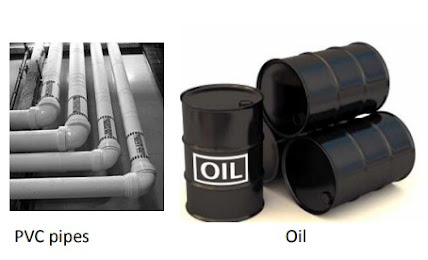PETROCHEMICALS
Petrochemicals are chemicals made from
petroleum (crude oil) and natural gas.
Petroleum and natural gas are made up of
hydrocarbon molecules, which are
comprised of one or more carbon atoms, to
which hydrogen atoms are attached.
Oil and gas are the main sources of the raw
materials because they are the least
expensive, most readily available, and can
be processed most easily into primary
petrochemicals, such as olefins (ethylene,
propylene and butadiene) aromatics
(benzene, toluene, and xylenes); and
methanol.
Uses of petrochemicals
Primary petrochemicals can be converted
chemically to form more complicated
derivative products such as
1. vinyl acetate for paint, paper and
textile coatings,
2. vinyl chloride for polyvinyl chloride
(PVC),
3. ethylene glycol for polyester and
textile fibres,
4. styrene which is important in rubber
and plastic manufacturing.
5. Petrochemicals have had a dramatic
impact on our food, clothing, shelter
and leisure.
6. Some synthetics, tailored for particular
uses, actually perform better than
products made by nature because of
their unique properties.
(Some end products of petrochemicals)
Cracking
Cracking is the process of breaking long-chain hydrocarbons into short ones.
The rate of cracking and the end products
are strongly dependent on the temperature
and presence of catalysts.
Oil refinery cracking processes allow the
production of light products such as
liquefied petroleum gas (LPG) and petrol
from heavier crude oil distillation fractions
such as gas oils and residues.
Fluid
catalytic cracking produces a high yield of
petrol and LPG, while hydro-cracking is a
major source of jet fuel, diesel, naphtha
and LPG.
Fractional distillation of petroleum
Petroleum refining is the process of
separating the many compounds present in
crude petroleum.
The principle which is
used is that the longer the carbon chain, the
higher the temperature at which the
compounds will boil.
Fractional distillation process
The crude petroleum is heated and
changed into a gas.
The gas is passed through a distillation
column which becomes cooler as the
height increases.
When a compound in the gaseous
state cools below its boiling point, it
condenses into a liquid.
The liquids may be drawn off the
distilling column at various heights.
Many kinds of compounds including
alkenes are made during the cracking
process.
(Uses of the various fractions of distillation)






No comments:
Post a Comment